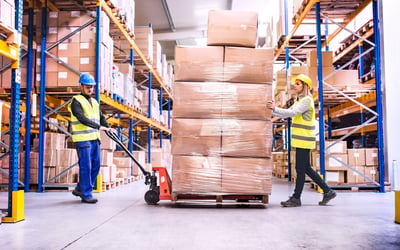Freight forwarding basics: proper packaging
Great packaging can mean the difference between a shipment arriving unscathed to its destination and one that is damaged or lost along the way.
According to the Institute of Packaging Professionals (IOPP), carriers may load/reload packages as many as five times during a relatively short distance shipment—and even more loading, unloading, and sorting happens on long hauls.
Cargo shipping presents a number of possible dangers, but the five main transportation hazards your shipments may face are:
- Shock
- Vibration
- Compression
- Extreme climate conditions
- Altitude
Your packaging needs to be able to withstand these hazards and the expected wear and tear of domestic and international transportation.
Check your carrier’s requirements and restrictions
Each carrier has its own terms and conditions that affect freight packaging. It is the shipper's responsibility to determine if their freight shipments meet those carrier's Terms and Conditions.
Common requirements and restrictions include: 
- Size limits
- Weight limits
- Perishables
- Labeling
- Special commodity packaging instructions
- Shipments requiring advanced arrangements
- Not acceptable items
- Limitation of liability
- Maximum declared value
It’s also useful to define or determine which type of load your goods are part of or constitute.
Easy loads
Moderate density items that may completely fill the container. They aren’t readily damaged by puncture or shock, don’t shift or move inside the package system, and don’t present a hazard to other freight shipments.
Average loads
Moderately concentrated items that provide partial support to all surfaces of the container. Average loads can be placed directly in the shipping container or use intermediate packaging.
Difficult loads
Items that require a lot of protection to prevent puncture, reduce shock, and don’t support the container. Fragile objects, delicate instruments, or items with uneven weight distribution may fall into this category.
Some packaging pro tips
- Palletize your shipment to ensure handling efficiency and reduce package damage.
- Include a packing/handling base to maintain package orientation, efficiency, safety, and protection.
- Shipments should be stackable, or you may be facing a surcharge with some carriers.
- Temperature fluctuations are likely. Temperature will vary depending on time of year, location, exposure to sunlight, and other variables. Summer temperatures in cargo areas can be up to 30 degrees higher than the temperature outside.
- Use unbreakable banding on large pieces. Band individual pieces over 150 lbs. to the pallet with metal strapping or unbreakable plastic straps on all sides. Hardened containers like plywood or metal that aren’t banded should have an exterior lock or clamp.
Packaging materials for shipping large items
Boxes aren’t the only way to pack your goods. Here are some other packaging materials you can use to pack and ship your freight.
- Shipping pallets
- Shipping crates
- Freight boxes
- Bagged products
- Drums and pails
- Spools and reels
- Transit cases
Securing freight shipments
To protect against shock and vibration, most products need protective packaging like cushioning, bracing, or wrapping. A few ideas to consider:
- Foam cushioning
- Blocking
- Bracing
- Load protectors
- Edge or angle boards
- Bands
- Stretch wrap (use 70-gauge)
Don’t forget the labels
Clearly labeled goods are goods that are handled correctly and delivered to the right place!
- Ensure that the labels are easily visible. For fragile items, considering labeling the box with a picture of the freight.
- Make sure your label communicates everything your carrier needs to know about your freight: delivery address, handling instructions (fragile, top stow only, this way up, etc.)
- Don’t put labels directly onto the surface of your goods, as this could cause damage
Check out Cole's Shipping Tools for more freight forwarding resources. And remember: experience, expertise and a commitment to service is what makes a freight forwarder great. Let us put our greatness to work for you.
Freight Solutions. It’s what we do.

Latest Articles
- Watch out for these extra charges on your freight bill
- Key differences between duty drawbacks and duty refunds for importers
- Mitigating container shortages and rising shipping prices for ocean imports
- How Canadian importers benefit from end use tariff codes and conditional relief
- The benefits of operating as a Non-Resident Importer in Canada

